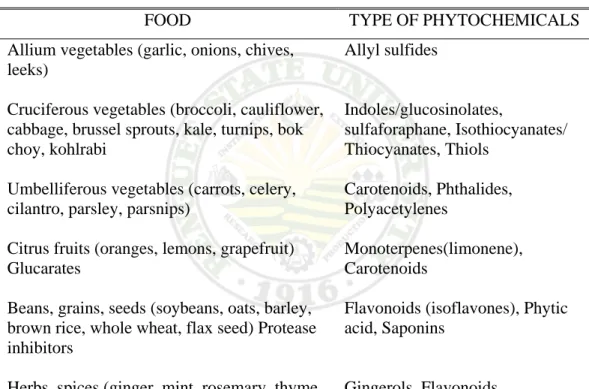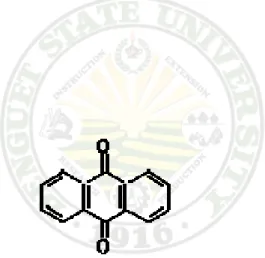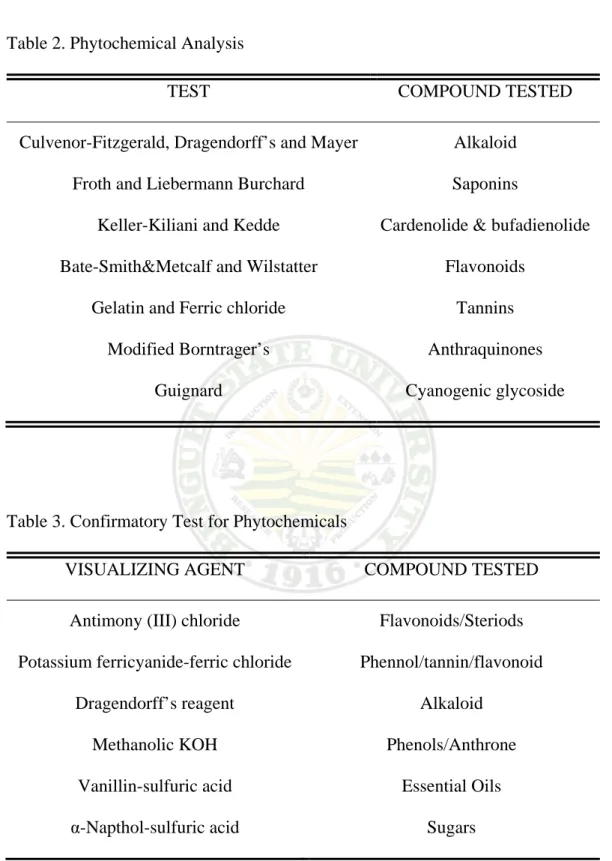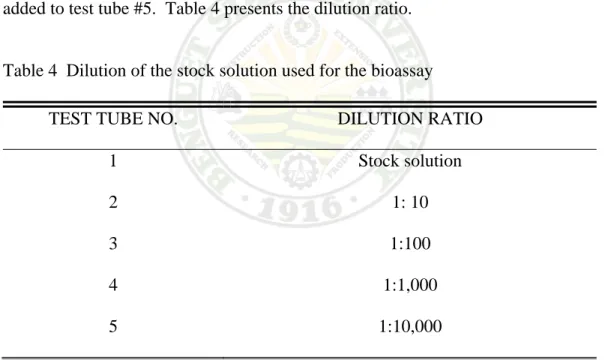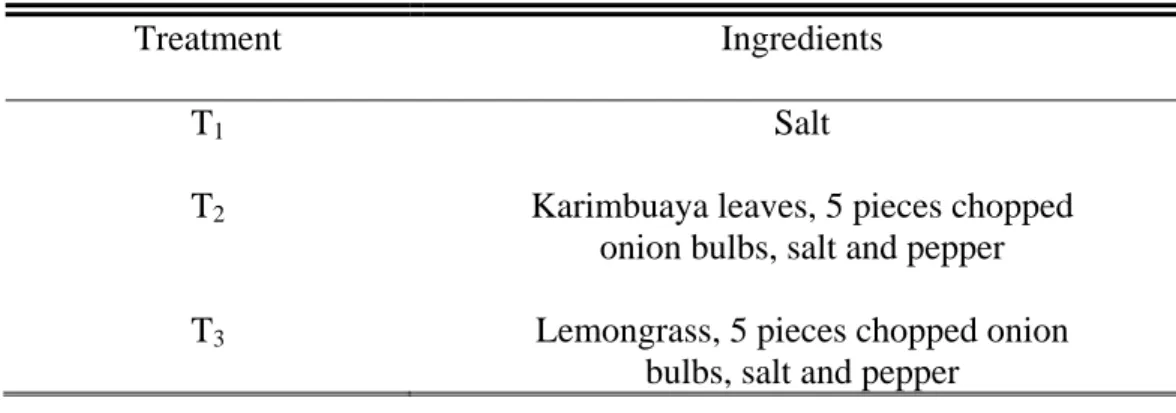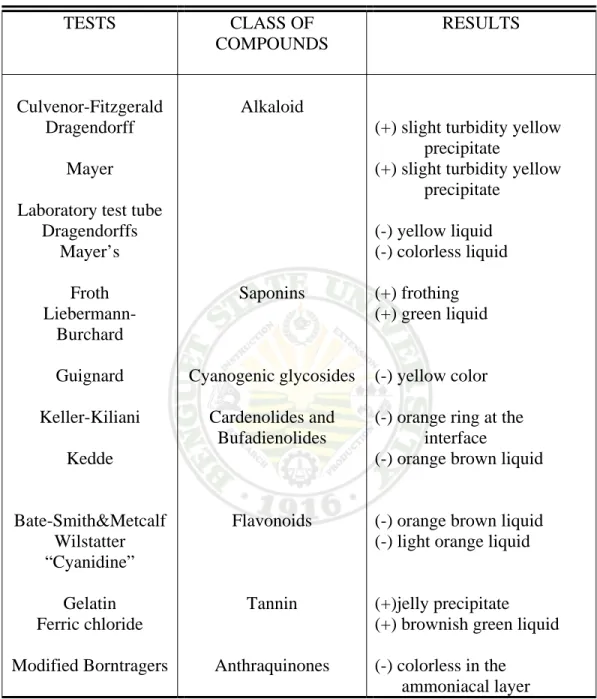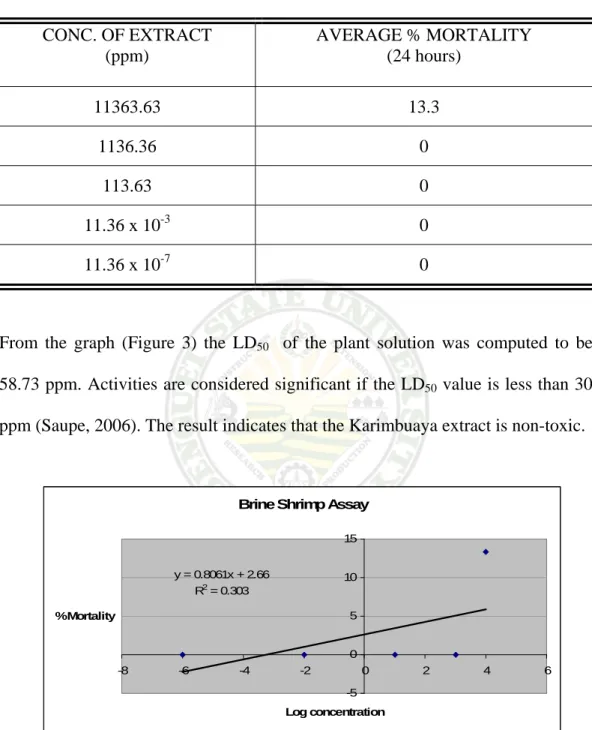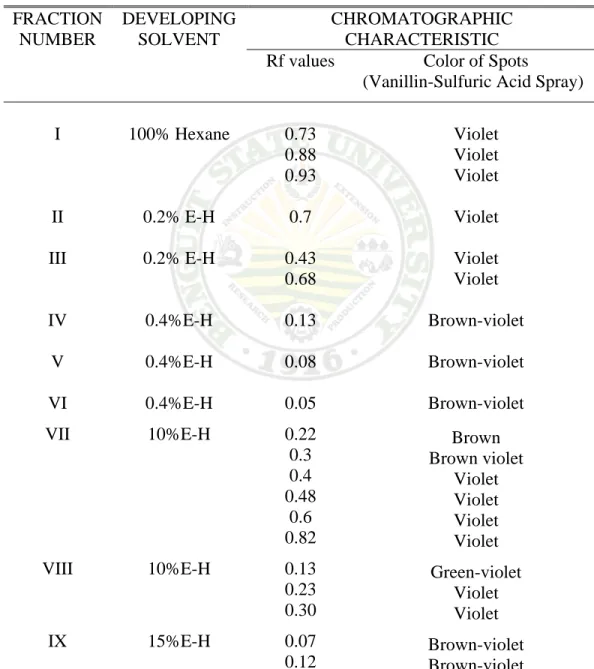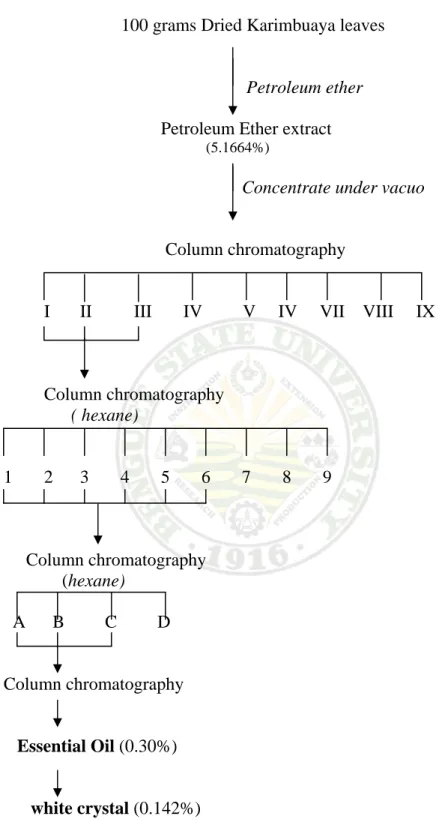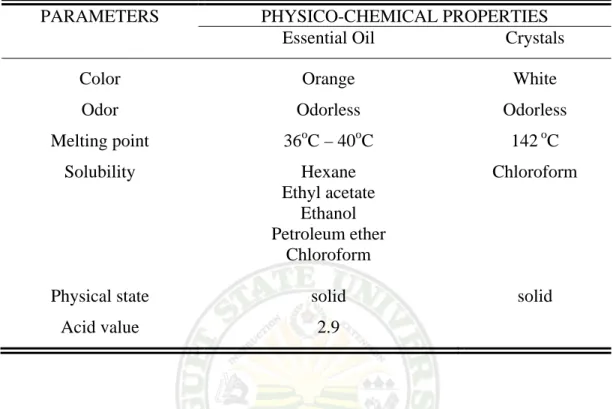Characterization of the Essential Oil from the Leaves of Karimbuaya (Euphorbia neriifolia Linn). Benguet State University, La Trinidad, Benguet.
Adviser: Louisa P. Pladio, M.S.
ABSTRACT
The fresh Karimbuaya (Euphorbia neriifolia Linn.) leaf extract was determined to be green, with leafy like odor, sweet with an after taste and contains 4.2% mass sucrose.
Phytochemical analysis showed that the fresh leaf extract contains saponin and tannin, but it is found non-toxic. The LD50 of the fresh leaf extract using the brine shrimp toxicity assay was 58.73 ppm.
The essential oil from the leaves of Karimbuaya (Euphorbia neriifolia Linn.) was extracted using a combination of Soxhlet extraction and chromatographic separation techniques. The chromatogram of the product obtained showed 4 spots with Rf values 0.20, 0.52, 0.8, and 0.95. The fatty like, odorless, and orange colored essential oil has a melting point range of 36-40oC and is found soluble in all organic solvents used in the solubility test. One component isolated from the essential oil is a white crystalline solid found to have a high affinity with chloroform and melts at 142oC. The percentage yield of the white crystal was 0.142%
The consumer panel type evaluation conducted showed that Karimbuaya mixture as flavor enhancer for grilled chicken is favored over the use of salt or lemongrass mixture.
Abstract . . . i
Table of Contents . . . ii
INTRODUCTION Background of the Study . . . 1
Importance of the Study . . . 3
REVIEW OF LITERATURE Karimbuaya (Euphorbia neriifolia Linn.) Botanical Description . . . 4
Bioactivity . . . 5
Flavor enhancers . . . 6
Plant Flavor Enhancer . . . 6
Synthetic Flavor Enhancer . . . 7
Essential Oil . . . 8
Toxicity Test Brine Shrimp Assay . . . 10
Phytochemical Screening . . . 10
Alkaloids . . . . . 12
Saponins . . . 12
Cardenolides and Bufadienolides . . . 13
Flavonoids . . . 14
iii
Extraction of Essential Oil . . . 17
Soxhlet Extraction . . . 17
Chromatography . . . 18
MATERIALS AND METHODS Plant Material Collection of Plant Sample . . . 19
Plant Preparation . . . 19
Characterization of the Fresh Karimbuaya Leaf Extract Physico-Chemical Properties . . . 20
Phytochemical Screening . . . 20
Toxicity Test . . . 22
Hatching of Brine Shrimp Eggs . . . 22
Preparation of Stock Solution . . . 22
Dilution of the Stock Solution . . . 23
Bioassay Procedure . . . 23
Data Analysis . . . 24
Extraction of the Essential Oil Soxhlet Extraction . . . 24
Chromatographic Separation . . . 25
Purification of the Essential Oil Extract . . . 25
Acceptability Test . . . 31
Preparation of Sample . . . 31
Taste Test . . . 32
Data Analysis . . . 32
RESULTS AND DISCUSSION Characterization of the Fresh Karimbuaya Leaf Extract. . . . 33
Physico-Chemical Properties . . . 33
Phytochemical Screening . . . 33
Toxicity Test Using The Brine Shrimp Assay . . . 41
Extraction of Essential Oil Crude Fat Extraction . . . 43
Separation of Essential Oil . . . 43
Purification of Essential Oil . . . 46
Characterization of the Essential Oil Physico-Chemical Properties . . . 48
Acceptability of Karimbuaya Leaves as Flavor Enhancer. . 51
SUMMARY, CONCLUSION and RECOMMENDATION 55 LITERATURE CITED . . . 58
APPENDICES . . . 62
BIOGRAPHICAL SKETCH . . . 67
Extraction and Characterization of the Essential Oil from the Leaves of Karimbuaya (Euphorbia neriifolia Linn) /Maria Theresa C. Macaraeg – Diza. 2006
INTRODUCTION
Background of the Study
Flavor enhancers are used to intensify or improve food flavor. Essential oil from plants and culinary herbs include a broad range of plant species that are used for flavor enhancement in food and beverages, as well as fragrances in pharmaceutical and industrial products. Essential oil are derived from aromatic plants of many genera which are distributed worldwide. These oils are not only used for flavor enhancement, but they are also used in aromatherapy, a form of herbal medicine in which healing effects are ascribed to the aromatic compounds in essential oils and other plant extract.
Culinary herbs refer to herbaceous aromatic plants grown and marketed fresh or dried and include aromatic plants which are grown for their extractable essential oils. Significant quantities of dried culinary herbs are imported into the Philippines. A large amount of selected herbs are domestically produced for the dried spice or condiments market.
Many herbs are commercially produced, albeit in small quantities, often in relatively small farms. Herbs which show promise for the fresh market and as source of essential oil are coriander (Coriandrum sativumL), oregano (Origanumspp), celery (Apium graveolens L), lemon (citrus limon L), anise (Pimpinella anisum L.), lemongrass (Cymbopogon citrates), and parsley (Petroselinum crispum Mill.).
Herbs and essential oils are used in a variety of meat and sausage products, salads, stews, sauces and soups.
Filipinos love to eat food’s mixed with flavor enhancers. They used mostly artificial flavoring and only few use fresh herbs. Lechon, grilled whole pig, or chicken is one among the favorites of Filipinos. This Filipino delicacy is always present in the table during Filipino occasions. The taste of lechon is enhanced by putting herbs inside the pig or chicken before it is grilled. Lemongrass commonly known as tanglad is favored by Cebuanos as a flavor enhancer, Ilocanos on the other hand use Karimbuaya.
Karimbuaya (Euphorbia neriifolia Linn) as locally known by the Ilocanos is popular for enhancing the flavor of lechon. The leaves of this plant is used for lechon baboy (grilled pig),and lechon manok (grilled chicken). Hearsay claims that the plant gives a distinct aroma and sweet taste to the meat. The introduction of the use of Karimbuaya as a food flavor enhancer would contribute to the growth of the fresh herb market.
The extraction and characterization of the essential oil from the leaves of Karimbuaya (Euphorbia neriifolia Linn.) using physico-chemical test, phytochemical screening and toxicity testing was conducted at the chemistry laboratory of the Department of Chemistry, Benguet State University, La Trinidad, Benguet. The study was done from June to October 2006.
This study aims to:
1. Characterize the crude extract from the fresh leaves of Karimbuaya.
2. Determine the toxicity of the leaves of Karimbuaya.
Extraction and Characterization of the Essential Oil from the Leaves of Karimbuaya (Euphorbia neriifolia Linn) /Maria Theresa C. Macaraeg – Diza. 2006
3. Extract and characterize the essential oil from the dry leaves of Karimbuaya.
4. Determine the acceptability of Karimbuaya leaves as a flavor enhancer.
Importance of the Study.
This study finds importance for providing the scientific basis for the utilization of Karimbuaya as a food flavor enhancer. The result of the study would encourage local farmers to cultivate the plant and thus provide them additional source of income for local farmers
REVIEW OF LITERATURE
Karimbuaya (Euphorbia neriifolia Linn.)
Botanical Description
The plant sample Euphorbia neriifolia Linn. have several scientific designation which include Euphorbia ligualaria Roxb., Euphobia pentagona Blanco, Euphorbia trigona Merr. It is commonly known as Bait (pamp), Karimbuaya (ilk), soro-soro (tag), and common milk hedge (eng). Karimbuaya is cultivated in gardens and is nowhere spontaneous. As shown in Plate 1a, this plant is a shrubby, erect, branched, fleshy, cactus like plant, 2 to 4 meters high, the trunk and older branches being grayish and cylindric: the medium branches being slightly twisted, stout, fleshy, and 4 or 5 angled or winged; the younger ones usually 3-winged, the wings
Extract (a) Plate 1. Ka
(b) lobulate, w bases at ea usually of millimeters garden as a
Bioactivity Ac are its con for earache Nadkarni s expressed j spasmodic
tion and Charac (Euphor arimbuaya (E Matured fre with a pair o ach leaf or p f 3 involucre s in diameter a hedge plant
y
cording to N stituents (An e. It is also states that th
juice of the l asthma. Th
cterization of rbia neriifolia Euphorbia ne esh leaves of stout, shar
petiole-scar.
es. The inv r with the lob t and it is pro
Nadkarni, Eup non, 2006).
similarly us he milky juic eaves is repo he leaves are
the Essential O Linn) /Maria
(b eriifolia Linn.
rp, 2-4mm lo The cymes volucres are bes fimbriate opagated by s
phorbon, resi A fluid extr sed in Malay ce of this tre orted as very e considered
Oil from the Le Theresa C. Ma b)
.) (a) Mature ong spines r are short, so green or p e (Plate 1b). T
stem cuttings
in gum caout racted from t ya, as reporte ee is used as
effective in r d diuretic. Th
eaves of Karim acaraeg – Diza d Karimbuay rising from t olitary in the pale yellow This plant is s (Anon., 200
tchouc, mala the roasted le ed by Burkil
a drastic ca relieving the he root mixe
mbuaya . 2006 ya tree the thickened e sinuses and and about 6 cultivated in 06).
ate of calcium eaves is used l and Haniff athartic. The
paroxysm o ed with black
d d 6 n
m d f.
e f k
pepper is employed in snake bites both internally and externally (Quisumbing, 1979).
The root is considered diuretic. According to folklore, the roots have been used for snake bites. The milky juice is regarded as a purgative internally and a rubefacient externally. Burkill quotes Dongen, who states that the latex maybe used as purgative, diuretic and vermifuge, and for asthma. Applied to glandular swellings, it prevents suppuration. Mixed with margosa oil, it is applied to limbs with contracted rheumatism. Turmeric powder mixed with the juice of Euphorbia neriifolia is recommended as an application to piles (Anon, 2006).
Euphorbia neriifolia Linn. shows wound healing activity in different pharmacological models and patients (Rasik, 1996). The resin obtained from the plant incorporated in the manufacture of a keratolytic ointment was proven effective in removing warts (Banaybay, 1980).
Flavor Enhancers
These are substances used to enhance the flavor of foods or to modify the flavor without contributing any significant flavor of their own. Controlled quantities of these plants are safe but if ingested in large quantities, they may lead to overdose.
Generating an overall flavor experience requires more than the basic taste. Aromas released in the mouth stimulate olfactory receptors and transmit odors to the brain.
The total flavor experience is a combination of taste, aroma and chemical feeling.
Cations produce physiological response recognized as saltiness in sodium cations. It is believed that the cations travel through special channels in the outer membrane of
Extraction and Characterization of the Essential Oil from the Leaves of Karimbuaya (Euphorbia neriifolia Linn) /Maria Theresa C. Macaraeg – Diza. 2006
taste cells and enter receptor cells. This changes the voltage across the receptor cell membrane, electrically exciting the cell and causing the release of neurotransmitters that stimulate nerve cells to signal saltiness to the brain. In addition, anions saccharin have been found to contribute to the sweet response in sodium saccharine (Hegenbart, 1996).
Plant Flavor Enhancer
Flavor enhancers are derived from plants and laboratory synthesis. The plant source can be used directly in fresh, dried, or powdered form.
Lemongrass is used mainly in cheap fragrance work. Its applications include aerosol deodorants, floor polishes, household detergents, and soaps (Robbins, 1983).
Basil is used in perfumery for its clear, sweet and mildly spicy aroma. Citronella oil, obtained from a relative of lemongrass, is used as an insect repellant and in perfumery. In food, several plant herbs are used to enhance the taste (Arctander, 1960).
In fish, meat and stir-fry dishes the following herbs are used as flavor enhancers: mustard (very potent), turmeric (very potent), garlic, thyme, rosemary, sage. Cayenne, cinnamon, cloves, ginger are not only used as flavor enhancers they also aid in digestion. For pasta dishes flavor enhancers are cayenne, turmeric, garlic, thyme, rosemary, ginger, mustard. Turmeric, garlic, sage, fennel, cinnamon powder, ginger, cloves are herbs used in baking. As flavor enhancers they also aid in digestion (Anon, 2006).
Synthetic Flavor Enhancer
An example of synthetic food enhancer is the monosodium glutamate (MSG).
MSG is the sodium salt of the amino acid glutamic acid. Its chemical formula is C5H5NO4Na. It is sold as a fine white crystal substance similar in appearance to salt or sugar. MSG is added as an ingredient to many snack foods, frozen dinners and instant meals like instant noodles. MSG stimulates specific receptors located in taste buds, like amino acid receptor (T1R1/T1R3), or metabotropic receptor (mGluR4 and mGluR1) which induce the taste known as umami. Umami is a Japanese loanword, referring to savoury or “more-ish”. Sensitivities to MSG like migraines, nausea, heart palpitations, asthma, and anaphylactic shock are attributed to the free glutamic acid component (Wikipedia, 2006). Chinese restaurant syndrome is often used as an example of MSG symptom complex, a condition characterized by one or more of the following symptoms: facial pressure, chest pain, violent dream, bronchospasm, burning sensation in the back of the neck, forearms and chest (FDA, 1993).
Glutamate is found naturally in our bodies and in protein-containing foods such as cheese, milk, meat, peas and mushrooms. Bound and unbound glutamates are found naturally in nearly every protein-rich food. Some of the glutamate in foods is in a “free form and this free form of glutamate enhances food flavor. Certain cheese or fermented protein products are due to the presence of free glutamate. Studies showed that glutamate in the body plays an important role in normal functioning of the nervous system raising questions about whether glutamate in food could affect the nervous system (Meadows, 2003).
Extraction and Characterization of the Essential Oil from the Leaves of Karimbuaya (Euphorbia neriifolia Linn) /Maria Theresa C. Macaraeg – Diza. 2006
Glutamic acid is an amino acid commonly found in foods. It belongs to the class of chemicals known as excitotoxins. Abnormally high levels of excitotoxins have been shown in hundreds of animal studies to cause damage to areas of the brain unprotected by the blood brain barrier and that a variety of chronic disease can arise out of this neurotoxicity (FDA, 1993).
Sodium chloride, table salt, is commonly used as a flavor enhancer for food and has been identified as one of the basic tastes (Sizer, 1997).
Essential oil
The oil derived from plants is called essential oil. Essential oils extracted from plants are concentrated hydrophobic liquid containing volatile aromatic compounds. It is also known as volatile oil and ethereal oil. It may also be referred as “oil of the raw plant material” from which it was extracted, such as oil of clove or lemongrass oil. The term essential is intended to indicate that the oil is the fragrant essence of the plant from which it is extracted and not in the more common sense of being indispensable (Wikipedia, 2006). Essential oils are found in plant oil cells, glandular trichomes and oil or resin ducts (Schnaubelt, 1999).
The formation and accumulation of essential oils in plants have been reviewed by Croteau (1986), Guenther (1972) and Runeckles and Mabry (1973).
Chemically, the essential oils are primarily composed of mono-and sesquiterpenes and aromatic polypropanoids synthesized via the mevalonic acid pathway for terpenes and the shikimic acid pathway for aromatic propanoids.
The essential oils from aromatic plants are for the most part volatile and thus, lend themselves to several methods of extraction such as hydrodistillation, steam distillation and solvent extraction (Guenther, 1972). The specific extraction method employed is dependent upon the plant material and the desired end-product. Essential oil components arise via the secondary metabolism of plants.
Citrus oils, produced by the mechanical pressing of citrus peels, are also called dry-distilled oils according to the International Standard Organization (ISO) (Simon, 1990).
Basil oil extracted from sweet basil Ocimum basilicum from the leaves and flowering tops are used as flavor enhancers for meat, pasta and fishes (Simon, 1990).
The European basil oils which are the highest quality contain methyl chavicol dlinalool (Guether 1985, Simon 1990).
In aromatherapy, to receive the healing effects of essential oils, they are used to massage into the skin, inhaled, or added to bath water (Burfield, 1990).
Toxicity Test Brine Shrimp Assay
Toxicity means the ability of a substance to cause harmful effect. The brine shrimp assay is a rapid, reliable, reproducible, non-tedious and inexpensive general bioassay tool for active plant extract. The procedure allows determination of the LD50
values in microgram per milliliter of active constituents in the brine shrimp medium.
This bioassay has been used in the analysis of natural products (Guevara, 2005). This is done by counting mortalities on artemia, adult brine shrimp.
Extraction and Characterization of the Essential Oil from the Leaves of Karimbuaya (Euphorbia neriifolia Linn) /Maria Theresa C. Macaraeg – Diza. 2006
Artemia salina, commonly known as brine shrimp are crustaceans that live in saline environment. Their eggs hatch quickly and the larvae are sensitive to small doses of biologically-active chemicals (Tarpley, 1958). Brine shrimp grow faster in slightly higher salt concentration but hatch more rapidly at lower salt concentration, 3.5% saline solution (Guevara, 2005).
Phytochemical Screening
The term “phytochemical” is derived from the Greek word phyto which means plant. This is defined as the nonnutrient compounds in plant-derived foods having biological activity in the body (Sizer, 1997). This include the compound that gives hot peppers their burning taste, the compound that gives garlic its pungent flavor, the pigments that give spinach and tomatoes their dark green and dark red color (Criag, 1996).
Phytochemicals have health enhancing abilities and possibly curative abilities. They number in the hundreds in most plant foods. They are found in fruits, vegetables, legumes and grains. Phytochemicals work together with nutrients to promote health and prevent diseases. Examples of phytochemicals include antioxidant, enzyme stimulators, estrogen, estrogen blockers, compounds that bind potential cancer-causing chemicals, suppressors of cancer cells (Malaspina, 1996).
Polk (1996) estimates that there may be more than 100 different phytochemicals in just one serving of vegetables. Table 1 shows the different kinds of food with their secondary metabolites.
According to Bloch (1995), phytochemicals are associated with the prevention and/or treatment of at least four of the leading causes of death in the United States -- cancer, diabetes, cardiovascular disease, and hypertension. They are involved in many processes including ones that help prevent cell damage, prevent cancer cell replication, and decrease cholesterol levels.
Table 1. Most common food analyzed with their Phytochemical constituent
FOOD TYPE OF PHYTOCHEMICALS
Allium vegetables (garlic, onions, chives, leeks)
Cruciferous vegetables (broccoli, cauliflower, cabbage, brussel sprouts, kale, turnips, bok choy, kohlrabi
Umbelliferous vegetables (carrots, celery, cilantro, parsley, parsnips)
Citrus fruits (oranges, lemons, grapefruit) Glucarates
Beans, grains, seeds (soybeans, oats, barley, brown rice, whole wheat, flax seed) Protease inhibitors
Herbs, spices (ginger, mint, rosemary, thyme, oregano, sage, basil, tumeric, caraway, fennel)
Allyl sulfides
Indoles/glucosinolates,
sulfaforaphane, Isothiocyanates/
Thiocyanates, Thiols Carotenoids, Phthalides, Polyacetylenes
Monoterpenes(limonene), Carotenoids
Flavonoids (isoflavones), Phytic acid, Saponins
Gingerols, Flavonoids, Monoterpenes (limonene)
Alkaloids
Alkaloids include literally thousands of bitter, nitrogenous compounds found throughout the plant kingdom. They often contain one or more rings of carbon atom with a nitrogen atom in the ring. The position of the nitrogen atom in the carbon rich
Extraction and Characterization of the Essential Oil from the Leaves of Karimbuaya (Euphorbia neriifolia Linn) /Maria Theresa C. Macaraeg – Diza. 2006
varies with different alkaloids and with different plant families. In some alkaloids, such as mescaline, the nitrogen atom is not in a carbon ring. The following alkaloids include belladonna type (atropine and cocaine), LSD-type (ergine and psilocybin) and peyote type (mescaline). Some of these have remarkable structural similarities with neurotransmitters in the human central nervous system, including dopamine, serotonin, and acetylcholine (Armstrong, 2001).
Saponins
Saponins are steroid/triterpenoid glycosides which are characterized by their ability to froth when the aqueous solution is agitated. They usually exert a powerful hemolytic action on red blood cells and when injected into the blood streams are highly toxic. Saponins are extracted from the plant material by hot water or alcohol and after concentration of the extract in vacuo, may undergo precipitation with ether.
A simple test for saponins is to shake an aqueous alcoholic plant extract in a test tube and note whether persistent honeycomb froth is formed above the liquid surface (Guevarra, 1979).
Saponins are natural surfactants or detergents extracted from plants which are commonly used as foaming agents for beverages (Clark, 2005). They have hemolytic, expectorative, anti-inflammatory and immune-stimulating activity. Saponin demonstrates antimicrobial properties against fungi, bacteria and protozoa. Saponins are found in number of herb including ginseng, paprika and red variety of onion (Sahelian, 2006).
Cardenolides and Bufadienolides
Cardenolides and bufadienolides are steroids containing deoxysugars and an unsaturated lactone ring. They are called “cardiac glycosides” as they act on the muscle of the heart. Plant extracts are usually evaluated for cardiotonic activity either through in-vitro or in-vivo biological tests. In phytochemical screening for cardiac glycosides, the test may be applied either to the crude alcoholic extract or the partially purified extract. Chemical test are designed to detect the presence of the deoxysugars, the steroid nucleus and the unsaturated lactone (Guevarra, 2005).
Flavonoids
The flavonoids are plant pigments based on C6-C3-C5 carbon skeleton and generally containing the γ-benzopyrone nucleus like the flavones (Figure 1a ), isoflavones, flavonols and flavonones. Other flavonoids are the anthocyanins (Figure 1b), leucoanthocyanins, catechins, chalcones, and aurones. Flavonoid compounds usually occur in plants as glycosides wherein one or more of the phenolic hydroxyl groups are combined with sugar residue. Many flavonoids exhibit different biological activities like antiviral, antifungal, anti-inflammatory and cytotoxic activities (Guevara, 2005).
Extract
(
Figure 1.
f c
Tannins Th raw anima Tannins co bonds.
Tan these sites death can t in the upp predators ( cytotoxic o
tion and Charac (Euphor a)
Flavonoids ( flavonoid; (b color in leave
e term “tann al skin into onsist mainly
nnins are loc they do not i they act to ha er epidermis (Guevara, 19 or antineopla
cterization of rbia neriifolia
(Wikipedia, b) anthocyan
es, stem, roo
nins” was firs leather beca y of gallic aci
cated mainly interfere with ave metabolic s. They serve 979). Recen astic agents.
the Essential O Linn) /Maria
2006) (a) fl nin that occur
ots, flowers a
st applied to ause of thei id residues th
y in the vacu h plant metab
c effects. In l e to reduce p nt studies sho In medicine
Oil from the Le Theresa C. Ma
avone are ke r in tissues o and fruits
plant constit ir ability to hat are linked
uoles or surfa bolism. Only
leaf tissues, t palatability a ows tannins tannins are
eaves of Karim acaraeg – Diza
(b)
etone derivat of plants that
tuents capabl cross-link w d to glucose v
face wax of t y after cell br
tannins are m and, thus, pr
have poten used as an a
mbuaya . 2006
tives of t provides
le of forming with protein via glycosidic
the plants. In eakdown and most common rotect agains ntial value as astringent and g n.
c
n d n st s d
for treatment of burns (Columbia Encyclopedia, 2006). In food, tannins are essential to the development of flavor in red wines (Klahorst, 2006).
Anthraquinones
Anthraquinones are naturally occurring quinine pigments. They occur in plants usually as hydroxylated, methylated, or carboxylated derivatives of anthraquinones, anthrones or dianthrone. They are commonly used as dyes and cathartics or purgatives (Guevara, 2005). Figure 2 shows the structural formula of anthraquinone
Figure 2. Chemical structure of Anthraquinone
Cyanogenic Glycosides
Cyanogenic glycosides are phytotoxins which occur in at least 2000 plant species of which a number of species are used as food in some areas of the world.
Cassava and sorghum are especially important staple foods containing cyanogenic glycosides (Nartey, 1980). Cyanide, released from a cyanogenic glycoside in food by
Extraction and Characterization of the Essential Oil from the Leaves of Karimbuaya (Euphorbia neriifolia Linn) /Maria Theresa C. Macaraeg – Diza. 2006
ß-glucosidase either of plant or from gut microflora origin and when taken up, follows the known cyanide metabolic pathway and toxicokinetics both for animals and man. Cyanide is detoxified by the enzyme rhodanase, forming thiocyanate, which is excreted by urine (Conn, 1979 a, b; Oke, 1979). Due to several factors influencing hydrolysis of cyanogenic glycosides and the confounding influence of nutritional status (such as riboflavin, vit. B12, sodium, methionine intake) human case studies and epidemiological studies of the chronic toxicological effects have shown very variable results and were not conclusive. In several studies both in animals and man the toxicity of cyanogenic glycosides is often expressed as milligram releasable cyanide (Conn, 1979 a, b).
Extraction of Essential Oil
Extraction refers to separating by physical or chemical means the desired material from a plant with the aid of a solvent (Bossert, 1970). Extraction procedure includes soxhlet extraction and column chromatography.
Soxhlet Extraction
Soxhlet extractor (Plate 2) is used to extract solutes from solids, using any desired volatile solvents, which can be water-miscible or water-immiscible (Morrison and Freiser, 1957). The solvent is vaporized and when it condenses, drops on the solid substance contained in the extraction thimble and extracts the soluble compounds. When the liquid level fills the body of the extractor, it automatically
siphons int is vaporize that analyz temperatur continuous
Chromatog Ch to be separ the other m sample mix component mobile pha a separatio material is plastic. Th a solvent o
to the flask. T ed and conden ze fats and o res in inert a s process (Lo
graphy hromatograph
rated are dist moves in a d xture are tran ts will have ase and will t on technique spread in a he separation or suitable mi
This process nsed. Soxhle oils in biolog atmospheres o et.al., 1983)
Plate 2. S
hy is a physic tributed betw definite direc nsported by different affi therefore mo e in which uniform thi n is carried ou
ixture of solv
is continuou et extractors a
gic samples.
on a micro o ).
Soxhlet extra
cal method o ween two pha
ction (IUPAC a mobile ph finities for th ve at differen a stationary n layer and ut by migrati vents.
usly repeated are standard Separations or macro sca
actor
of separation ases, one of C, 1993). Co ase over a st e stationary nt rates. Thin phase cons fixed on a s ion through t
as the solven equipment in s can be ach ale by a disc
in which the which is stat omponent m tationary pha
phase with r n-layer chrom
sisting of an support of gl the thin layer
nt in the flask n laboratories hieved at low continuous o
e components tionary while molecules in a ase. Differen respect to the matography is n appropriate lass, metal or r of solutes in k
s w r
s e a nt e s e r n
Extract Plate 3. Ch
flow due stat
tion and Charac (Euphor hromatograp ws down a c e to different tionary phase
cterization of rbia neriifolia hic separatio olumn packe t degree of in e. (IUPAC, 1
the Essential O Linn) /Maria on. A mixtur ed with statio nteraction bet
1993)
Oil from the Le Theresa C. Ma re of compou onary phase p tween sample
eaves of Karim acaraeg – Diza unds is separa
particles. Sep e molecules a
mbuaya . 2006 ated as it paration is
and
MATERI
Collection Ma as Karim provinces Biology H Plant Prep Th were wash dried leav shows sam
.
ALS AND M
n of Plant Sam atured leaves mbuaya, wer
north of M Herbarium, at
paration he collected
hed thorough es were cut mples ready f
Plate
METHODS
Th
mple s of Euphor re collected Manila. The t U.P. Dilim
mature leav hly with tap into small p for the extrac
e 4. Cut and S
he Plant Mat
rbia neriifoli d from Pan
plant samp man, Quezon
ves of Karim water and a pieces then p
ction proces
d powdered K terial
ia Linn comm ngasinan, an
le was iden City.
mbuaya (Eup ir dried for 1 powdered pr ss.
Karimbuaya
monly know nd Vigan, ntified at the
phorbia neri 10 days. Aft rior to analy
leaves
wn in ilocano Ilocos Sur e Institute o
iifolia Linn.
ter which the ysis. Plate 4 o r,
f
) e 4
Extraction and Characterization of the Essential Oil from the Leaves of Karimbuaya (Euphorbia neriifolia Linn) /Maria Theresa C. Macaraeg – Diza. 2006
Characterization of the Fresh Karimbuaya Leaf Extract Physico-Chemical Properties
The fresh leaves of Karimbuaya leaves were homogenized using a blender and the juice was extracted by the use of several layers of cheesecloth.
Color. The color of the extract was determined based on a color chart.
Taste. About 5 drops was used to taste the extract.
Odor. This process was done by smelling after the juices have been extracted from the leaves.
Refractive index. The amount of sugar on the sample was measured using Atago refractometer.
Phytochemical screening
The fresh Karimbuaya leaf extract was screened for the presence of phytochemicals using methods of Guevara (2005). The fresh extract was prepared by liquefying the thoroughly washed and drained fresh mature leaves of Karimbuaya (Euphorbia neriifolia Linn). Table 2 shows the different tests used for the phytochemical screening. A confirmatory test (Table 3) for the presence of secondary metabolites or phytochemicals using thin layer chromatography (TLC) was also performed using the methods from Guevara (2005).
Table 2. Phytochemical Analysis
TEST COMPOUND TESTED
Culvenor-Fitzgerald, Dragendorff’s and Mayer Froth and Liebermann Burchard
Keller-Kiliani and Kedde Bate-Smith&Metcalf and Wilstatter
Gelatin and Ferric chloride Modified Borntrager’s
Guignard
Alkaloid Saponins
Cardenolide & bufadienolide Flavonoids
Tannins Anthraquinones Cyanogenic glycoside
Table 3. Confirmatory Test for Phytochemicals
VISUALIZING AGENT COMPOUND TESTED
Antimony (III) chloride
Potassium ferricyanide-ferric chloride Dragendorff’s reagent
Methanolic KOH Vanillin-sulfuric acid α-Napthol-sulfuric acid
Flavonoids/Steriods Phennol/tannin/flavonoid
Alkaloid Phenols/Anthrone
Essential Oils Sugars
Extraction and Characterization of the Essential Oil from the Leaves of Karimbuaya (Euphorbia neriifolia Linn) /Maria Theresa C. Macaraeg – Diza. 2006
Toxicity Test
The toxicity of the Karimbuaya leaves was evaluated using the Brine Shrimp Assay.
Hatching of Brine Shrimp Eggs
A hatching medium was prepared by dissolving 3.8 grams of rock salt per 100 ml distilled water. This solution has a 3.8% NaCl concentration. About 250 mg of brine shrimp egg and 80 ml hatching medium were placed in the hatching dish. The hatching dish has two unequal compartment provided by a plastic divider punched with several 2 mm holes. The brine shrimp eggs were sprinkled into the larger compartment and then covered with cardboard to block the light.
The smaller compartment was illuminated for 48 hours to allow the eggs to hatch.
The nauplii were then harvested for the assay.
Preparation of Stock Solution
Fresh Karimbuaya leaves were washed thoroughly and oven dried at 60oC for 24 hours. About 500 mg of the dried leaves were powdered using mortar and pestle. The powdered sample was transferred to a 250 ml beaker and 50 ml of artificial sea water (3.8% NaCl) was added. The extract was filtered using 4 layers of cheesecloth following one hour of incubation. The filtrate collected is the stock solution.
Dilution of the Stock Solution
Five test tubes of 20 ml capacity were prepared and labeled (1to 5) for the dilution of the stock solution. The dilution series was prepared as follows: To test tube 1, 10 ml of the stock solution was placed while 9ml of artificial sea water (3.8% NaCl) was placed to test tube # 2 to 5. The dilution was carried out by transferring 1.0 ml stock solution from test tube #1 to test tube #2. From the mix solution in test tube #2, 1.0 ml was transferred to test tube #3, 1.0ml from test tube #3 was transferred to test tube #4 and from this, 1.0 ml was pipetted and added to test tube #5. Table 4 presents the dilution ratio.
Table 4 Dilution of the stock solution used for the bioassay
TEST TUBE NO. DILUTION RATIO
1 Stock solution
2 1: 10
3 1:100 4 1:1,000 5 1:10,000
Bioassay Procedure
The diluted stock solutions in the 5 test tubes were transferred to 5 previously cleaned petri dishes and labeled similarly as the test tubes. Using a Pasteur pipette, ten live brine shrimps (nauplii) were deposited in each Petri dish.
Extraction and Characterization of the Essential Oil from the Leaves of Karimbuaya (Euphorbia neriifolia Linn) /Maria Theresa C. Macaraeg – Diza. 2006
After 24 hours, the Petri dishes were examined for brine shrimp mortality with the aid of a magnifying lens.
Data Analysis
The toxicity of the plant extract was determined based on the value obtained for the LD50, which refers to the amount (lethal dose) of a substance that kills half of the test organisms. The LD50 was determined from the equation of the line obtained by plotting the percent mortality against the log extract concentration.
Extraction of the Essential Oil Soxhlet Extraction
Previously cut air dried Karimbuaya leaves were powdered using a blender. Each 15 gram batch of the powdered leaves was wrapped in filter paper and placed in the extracting thimble of a soxhlet extractor, where 250 mL of petroleum ether was added as the extracting solvent. The extraction process for each batch of leaves lasted for 5 hours, until the color of the solvent in the body of the soxhlet extractor became colorless. The petroleum ether extract was concentrated under reduced pressure at 40oC. The concentrated plant extract was allowed to dry to determine the percentage yield.
Chromatographic Separation
A weighed amount of the concentrated petroleum ether extract was subjected to rapid column chromatography by vacuum elution, as in Plate 5. A column of 4.5 cm diameter was packed with 7 cm high of Silica Gel 60 Gf (Merck). Solvent used for elution was increasing percentage of hexane-ethyl acetate mixture starting from pure hexane to 10% ethyl acetate.
The chromatographic separation of the ether extract was monitored through thin layer chromatography using prepared TLC plates (Merck). The chromatograms were developed using different solvent system based on the concentration of the solvent used for elution. The spots were first developed using iodine vapors followed by vanillin-sulfuric acid spray and was then heated in the oven at 110oC for color development. Components of the same Rf value were collected and grouped as one.
Plate 6 shows the over-all extraction process.
Purification of the Essential Oil Extract
Repeated column chromatography using different column sizes and isocratic elution yielded the oil extract. This is illustrated in Plate 7. Isocratic elution was carried out using pure hexane (A.R. grade). The fraction identified by TLC to contain the essential oil was further separated using a smaller column (2.0 cm in diameter). Solubility difference using pure ethyl acetate (A.R.) and filtration with the use of Whatman 42 separated the white crystals from the oil.
Extract
Plate
tion and Charac (Euphor
5. Column Petroleu
cterization of rbia neriifolia
Chromatogr um ether ext
1
4
7
the Essential O Linn) /Maria
raphic Separ tract from K
Oil from the Le Theresa C. Ma
ration of the Karimbuaya
2
5
8
eaves of Karim acaraeg – Diza
e Concentrat leaves
mbuaya . 2006
ted 6 3
9
Plate 6. Schematic diagram of the extraction of Essential oil from the leaves of Karimbuaya.
Fresh leaves of Karimbuaya
Dried Powderized Leaves
Soxhlet extraction
Essential Oil
Ether extract
Concentrated under vacuo (rotary evaporator)
Separation by Column Chromatography Fractions containing
Essential Oil
Concentrated Petroleum Ether Extract
Extract
Plate 7.
tion and Charac (Euphor
Chromatogr
cterization of rbia neriifolia
raphic Separ
the Essential O Linn) /Maria
ration of Ess
Oil from the Le Theresa C. Ma
sential Oil fr
eaves of Karim acaraeg – Diza
rom Karimbu
mbuaya . 2006
uaya leaves
Characterization of the Essential Oil Extract Physico-chemical Test
Solubility test. Each two drops of extracted oil was mixed with 2 ml of the different organic solvent in a test tube. Solubility of the oil extract was determined in different organic solvent which included chloroform, ethanol, ethyl acetate, hexane and petroleum ether.
Melting point determination. The melting point of the oil extract was analyzed as follows: About 0.1ml of the viscous oil was placed in a 50 ml beaker that was suspended in a water bath. This set-up is shown in Plate 8. The temperature of the water bath starting from 10oC was gradually increased until the oil melted.
Plate 8. Melting point set-up for the essential oil
Extract
Th was analy crystals w to the capi Dennis tub melted. Th
Pla
Ac 12.5 ml of KOH until to indicate solution be
tion and Charac (Euphor
he melting p yzed using th
as placed in illary tube co
be filled wi he set-up is p
ate 9 A Thie
cid Number.
f ethanol (95 l a red color e the end poi efore and aft
cterization of rbia neriifolia
point of the he Thiele-D nside the sea ontaining th ith glycerol.
presented in
ele-Dennis tu crystal (Vis
About 100 5%) and 12.
r remains aft int of the tit ter titration.
the Essential O Linn) /Maria
white crysta Dennis tube.
aled capillary he sample an
. The tube w Plate 9.
ube for melti conde A.D.
0 mg of oil 5 ml ether.
ter swirling.
ration. Plate
Oil from the Le Theresa C. Ma
als separated About 1 m y tube. A th nd was then p
was heated
ing point det et al, 2003)
was mixed The mixture
Phenolphth e 10 presents
eaves of Karim acaraeg – Diza
d from the mm height o
ermometer w placed insid
until the w
termination
with mixtur e was titrate halein indicat
s the color o
mbuaya . 2006
extracted oi of the white was attached e the Thiele white crystals
of the
re containing d with 0.1M tor was used of the sample il
e d - s
g M d e
A. Before KOH Titration B. After KOH titration
Plate 10. Acid number determination of the Essential Oil
Acceptability Test
A consumer type panel consisting of 48 members ranging in age from 20 to 60 years was asked to evaluate the acceptability of the aroma and taste of lechon manok, grilled with Karimbuaya leaves. Common spices for flavoring lechon sold in the market were the standard ingredients in the acceptability test conducted.
Preparation of Sample.
Dressed chickens previously washed and drained were used for the three treatments. The chickens were then stuffed with the respective treatment ingredients as shown in Table 5. The stuffed chickens were grilled at the same time.
Extraction and Characterization of the Essential Oil from the Leaves of Karimbuaya (Euphorbia neriifolia Linn) /Maria Theresa C. Macaraeg – Diza. 2006
Table 5. Treatments used in the chicken for the acceptability test
Treatment Ingredients
T1 Salt
T2 Karimbuaya leaves, 5 pieces chopped onion bulbs, salt and pepper T3 Lemongrass, 5 pieces chopped onion
bulbs, salt and pepper
Taste Test
Before the taste test, a sensory evaluation form (Appendix B) was given to each consumer to mark after tasting. The grilled chickens were cut into bite sizes and given to the members of the panel. The consumers were asked to rinse their mouth with water after tasting each of the treated samples.
Data Analysis
One way ANOVA test was used to determine if there was a significant difference between the three treatments. Computer software SPSS was used in the data analysis. This software computes using the P-value approach.
RESULTS AND DISCUSSION
Characterization of the Fresh Karimbuaya Leaf Extract Physico-chemical Properties
The liquid squeezed from the homogenized fresh leaves of Karimbuaya was green in color, with a leafy like odor, and sweet with an after taste. The percentage (%) mass sucrose content of the fresh extract was 4.2%. This was obtained using a refractometer.
Phytochemical Screening
To identify the secondary metabolites present in the extract, phytochemical analysis was done. The results summarized in Table 6, showed that the fresh extract contains only the secondary metabolites, saponin and tannin.
Although a slight turbidity was observed in the Culvenor-Fiztgerald test for alkaloid, this result is considered negative according to Guevara (2005). Presence of alkaloid in the sample is indicated by a heavy precipitation evaluated as (+++).
The result of on the Laboratory test tube method, no formation of precipitates, confirms that alkaloid is not present in the sample.
Plate 11 represents the above results.
Extraction and Characterization of the Essential Oil from the Leaves of Karimbuaya (Euphorbia neriifolia Linn) /Maria Theresa C. Macaraeg – Diza. 2006
Table 6. Phytochemical Analyses of Fresh Karimbuaya Leaf Extract
TESTS CLASS OF
COMPOUNDS
RESULTS
Culvenor-Fitzgerald Dragendorff
Mayer Laboratory test tube
Dragendorffs Mayer’s
Froth Liebermann-
Burchard Guignard Keller-Kiliani
Kedde
Bate-Smith&Metcalf Wilstatter
“Cyanidine”
Gelatin Ferric chloride Modified Borntragers
Alkaloid
Saponins
Cyanogenic glycosides Cardenolides and
Bufadienolides
Flavonoids
Tannin Anthraquinones
(+) slight turbidity yellow precipitate
(+) slight turbidity yellow precipitate
(-) yellow liquid (-) colorless liquid (+) frothing (+) green liquid (-) yellow color (-) orange ring at the interface
(-) orange brown liquid (-) orange brown liquid (-) light orange liquid (+)jelly precipitate (+) brownish green liquid (-) colorless in the
ammoniacal layer
To confirm the above results, phytochemical analyses using thin-layer chromatography (TLC) was also performed. The tests confirmed the presence of saponin and tannin. The absence of alkaloids and other secondary metabolites
A. Alkal Plate 11. P
loid Test (ne Phytochemic
egative result cal Screening t) g Result
Extraction and Characterization of the Essential Oil from the Leaves of Karimbuaya (Euphorbia neriifolia Linn) /Maria Theresa C. Macaraeg – Diza. 2006
Plate 11. Continued…
B. Saponin (positive result)
C. Cyanogenic glycosides Plate 11. Continued…
D. Cardenolides and Bufadienolides (negative result) Plate 11. Continued…
Extraction and Characterization of the Essential Oil from the Leaves of Karimbuaya (Euphorbia neriifolia Linn) /Maria Theresa C. Macaraeg – Diza. 2006
E. Flavonoids Plate 11. Continued …
F. Tannins (positive result) Plate 11. Continued….
Extraction and Characterization of the Essential Oil from the Leaves of Karimbuaya (Euphorbia neriifolia Linn) /Maria Theresa C. Macaraeg – Diza. 2006
G. Anthraquinone (negative result)
were also confirmed. The results are presented in Table 7. The same table also shows that essential oil and sugar are present in the fresh extract. The violet spots observed upon spraying the developed TLC plates with the vanillin-sulfuric acid visualizing agent, indicate that the extract contains essential oil. Using the α- Napthol-sulfuric spray reagent, a blue spot was observed which confirmed the presence of sugar in the Karimbuaya leaves. Results collaborates the finding using refractometer for the presence of sugar.
Table 7. Phytochemical Analyses using Thin-Layer Chromatography (TLC)
SPRAY REAGENTS CONSTITUENT TESTED RESULT
Antimony(III) chloride Flavonoids/steroids (-) no spot Potassium ferricyanide-
ferric chloride
Phenol/tannin/flavonoid (-) yellow spot
Dragendorff’s reagent Alkaloid (-) yellow spot KOHmethanolic Phenols/anthrone (-) no spot
Vanillin-sulfuric acid Essential oils (+) wide range of color α-Napthol-sulfuric acid Sugars (+) blue spot
Toxicity Test Using The Brine Shrimp Assay
Table 8 showed that the concentrated stock solution of Karimbuaya has an average of 13.3 % mortality after 24 hours. The diluted concentration of the stock solution showed 0% mortality on the nauplii.
Extraction and Characterization of the Essential Oil from the Leaves of Karimbuaya (Euphorbia neriifolia Linn) /Maria Theresa C. Macaraeg – Diza. 2006
Brine Shrimp Assay
y = 0.8061x + 2.66 R2 = 0.303
-5 0 5 10 15
-8 -6 -4 -2 0 2 4 6
Log concentration
% Mortality
Table 8. Average % mortality after 24 hours CONC. OF EXTRACT
(ppm)
AVERAGE % MORTALITY (24 hours)
11363.63 13.3 1136.36 0
113.63 0
11.36 x 10-3 0
11.36 x 10-7 0
From the graph (Figure 3) the LD50 of the plant solution was computed to be 58.73 ppm. Activities are considered significant if the LD50 value is less than 30 ppm (Saupe, 2006). The result indicates that the Karimbuaya extract is non-toxic.
Figure 3. Determination of LD50
Crude Fat Th grams of p yield 5.16 recovered the crude f
Separation Th extract a chromatog to elute the nine fracti
Extraction he petroleum
powdered dr 664 gram of crude fat is fat
n of Essentia he essential fter repeate graphic techn e essential o ons obtained
Extrac
ether extrac ried Karimb f crude fat solid and co
Plate 12. E K al Oil
oil was ob ed chroma niques. Isoc oil. Table 9 s d from the cr
ction of Esse
ct obtained fr buaya leaves or concent olored dark
Extracted cru Karimbuaya
tained from tographic p cratic elution shows the ch rude fat. The
ential Oil
from the soxh s was dried trated petrol green. Plate
ude Fat from a
m the crude processes g n using pure hromatograp ese fractions
hlet extractio under vacuo leum ether
12 shows th
m
fat or petr guided by e hexane wa
hic characte s are shown i
on using 100 o at 40oC to extract. The he sample o
roleum ether thin layer as performed eristics of the in Plate 13.
0 o e f
r r d e
Extraction and Characterization of the Essential Oil from the Leaves of Karimbuaya (Euphorbia neriifolia Linn) /Maria Theresa C. Macaraeg – Diza. 2006
Essential oils, because they are non-polar are the first to be eluted from the column. Based on the TLC chromatogram, fractions I to III which contain the oil were pooled and concentrated under vacuo at 40oC.
Table 9. Thin-Layer Chromatography of the Petroleum Ether Extract FRACTION
NUMBER
DEVELOPING SOLVENT
CHROMATOGRAPHIC CHARACTERISTIC Rf values Color of Spots
(Vanillin-Sulfuric Acid Spray) I
II III IV V VI VII
VIII
IX
100% Hexane
0.2% E-H 0.2% E-H 0.4%E-H 0.4%E-H 0.4%E-H 10%E-H
10%E-H
15%E-H
0.73 0.88 0.93 0.7 0.43 0.68 0.13 0.08 0.05 0.22 0.3 0.4 0.48
0.6 0.82 0.13 0.23 0.30 0.07 0.12
Violet Violet Violet Violet Violet Violet Brown-violet Brown-violet Brown-violet
Brown Brown violet
Violet Violet Violet Violet Green-violet
Violet Violet Brown-violet Brown-violet
* E-H Ethyl acetate in hexane
Plaate 13. Eluat conce
tes from the entrated petr
Column Ch roleum extra
hromatograph act of the Kar
hy from the rimbuaya leaaves
Extract
Th chromatog extraction was obtain Th indicating the separat Figure 4.
Purificatio Th spot (Plate 0.20 corre
tion and Charac (Euphor
he pooled F graphy to y
using chrom ned. This is he chromato the presenc tion of the e
on of Essenti he essential o
e 14) locate sponds to th
Plate 14
cterization of rbia neriifolia
Fractions (I yield 9 frac matographic
the essential gram (Plate ce of four c
ssential oil f
ial Oil oil extracted
d at the low he white crys
4. Chromato Vanillin-su
the Essential O Linn) /Maria
I-III) was ctions as sh
techniques, l oil.
e 14) of the omponents.
from the leav
d showed pr wer part of t
stals.
ogram of the ulfuric acid a
Oil from the Le Theresa C. Ma
again subje hown in Fi
an orange-c
e essential The over-al ves of Karim
resence of w the chromat
e essential oi as visualizin
eaves of Karim acaraeg – Diza
ected to ra gure 4. A olored fat-li
oil showed ll extraction mbuaya is su
white crystal ogram with
il using ng agent
mbuaya . 2006
apid column After severa
ke substance
d four spots n process for ummarized in
ls. The large Rf value o
n
al e
s, r n
e f
100 grams Dried Karimbuaya leaves
Petroleum ether
Petroleum Ether extract (5.1664%)
Concentrate under vacuo
Column chromatography
I II III IV V IV VII VIII IX
Column chromatography ( hexane)
1 2 3 4 5 6 7 8 9
Column chromatography (hexane)
A B C D
Column chromatography
Essential Oil (0.30%)
white crystal (0.142%)
Figure 4. Schematic diagram of the Over- all Extraction of Essential oil
Extract
The presen room temp the white ethyl acet recovery f
Plate 15
Physico-ch Tab essential o
tion and Charac (Euphor
nce of the c perature. Ap
crystals wer tate solution for the white
5. White Cry
hemical Prop ble 10 gav oil and the w
cterization of rbia neriifolia
crystals prob pplying selec re separated n was used
crystals wa
ystal Isolate f Characteriz perties e a summa white crystals
the Essential O Linn) /Maria
bably explai ctive solubil d from the o
to recover s 0.142%.
from the leav zation of the
ary of the p s isolated fro
Oil from the Le Theresa C. Ma
ins why the ity differenc oil. This is s the oil from
ves of Karim Essential O
physico-chem om the leaves
eaves of Karim acaraeg – Diza
essential o ce followed shown in Pl m the mixt
mbuaya Oil
mical prope s of Karimbu
mbuaya . 2006
il is solid a by filtration late 15. Pure ture. Percen
erties of the uaya.
at n, e nt
e
Table 10. Physico-chemical Properties of the Essential Oil and Crystal
PARAMETERS PHYSICO-CHEMICAL PROPERTIES
Essential Oil Crystals
Color Odor Melting point
Solubility
Physical state Acid value
Orange Odorless 36oC – 40oC
Hexane Ethyl acetate
Ethanol Petroleum ether
Chloroform solid
2.9
White Odorless
142 oC Chloroform
solid
Essential Oil. The essential oil extracted was odorless and orange in color.
This is shown in Plate 16. The melting point determined ranges from 36-40oC.
The wide range of melting point denotes that the oil has other components, which is confirmed by the presence 4 spots observed in the chromatogram revealed in Plate 14. The essential oil is soluble in all of the organic solvents used in the solubility test. The oil has an acid value of 2.9. The acid value measures the amount of the fatty acids hydrolyzed. The higher acid number indicates the degree of degradation of the oil (Anon, 2006).
Crystals. The solid separated from the essential oil is white in color and is odorless. It has a melting point of 142oC. The solubility of the crystal was tested
Extraction and Characterization of the Essential Oil from the Leaves of Karimbuaya (Euphorbia neriifolia Linn) /Maria Theresa C. Macaraeg – Diza. 2006
A B
C
Plate 16. A. Essential oil extracted from Karimbuaya leaves B. top view of the oil in the beaker
C. The essential oil in a Florence flask after concentrating in vacuo
in several organic reagents and is found soluble in chloroform. as shown in Table 11.
Table 11. – Solubility of the White Crystal Isolate
REAGENTS RESULT REAGENTS RESULT
70% ethanol Insoluble Ethyl acetate Insoluble
80% ethanol Insoluble Hexane Insoluble
85% ethanol Insoluble Diethyl ether Insoluble 90% ethanol Insoluble Chloroform Soluble Petroleum ether Insoluble 2%EtOAc-Hexame Insoluble
Acceptability of Karimbuaya Leaves as a Flavor Enhancer
The sensory attributes of foods are of paramount importance as people take pleasure from a combination of their visual, olfactory, taste and tactile perception. Overall flavor requires not just the basic taste: sweet, salty, bitter, and sour. According to Hegenbart(1996) the total flavor experience is a combination of taste, aroma and the chemical feeling. Modifications on the flavors of food are achieved by addition of flavor enhancers.
Extraction and Characterization of the Essential Oil from the Leaves of Karimbuaya (Euphorbia neriifolia Linn) /Maria Theresa C. Macaraeg – Diza. 2006
The acceptability of fresh Karimbuaya leaves as a flavor enhancer in lechon preparation was compared to the common commercial ingredients. The aroma, taste and overall acceptability were evaluated.
Table 12. Multiple Comparison on Aroma
SAMPLE MEAN DIFFERENCE
SIG.
Karimbuaya mixture vs. salt only Karimbuaya mixture vs. Lemongrass mixture
Salt only vs. Lemongrass mixture
0.38 0.52* 0.15
0.202 0.046 0.784
* significant at 0.05 Aroma
Table 12 shows that the mean difference of 0.38 between Karimbuaya mixture and salt only is not significant at the 0.05 level. This indicates that there is no difference on the aroma of the grilled chicken stuffed with Karimbuaya mixture and salt only, respectively. On the other hand, between Karimbuaya mixture and lemongrass mixture, the mean difference (0.52) is significant. This implies that the aroma of grilled chicken as enhanced by Karimbuaya leaves is preferred by the consumer panel. Between the two standard ingredients, salt only and lemongrass mixture, the mean difference is not significant. This shows that the aroma of grilled chicken stuffed with lemongrass is the same as that of the salt.
Table 13. Multiple Comparison on Taste
SAMPLE MEAN DIFFERENCE
SIG.
Karimbuaya mixture vs. salt only Karimbuaya mixture vs. Lemongrass mixture
Salt only vs. Lemongrass mixture
0.15 0.96* 0.81*
0..820 0.000 0.002
* significant at 0.50 Taste
Comparing the taste of the grilled chicken treated with Karimbuaya mixture to the one treated with salt only, the mean difference (0.15) obtained is not significant. The result implies that the taste is the same. Karimbuaya mixture when compared with lemongrass mixture, the mean difference is significant. This means the consumers prefer the taste of chicken flavored with Karimbuaya mixture than the lemongrass mixture. The standard ingredients used in the analysis, salt only and lemongrass mixture, revealed a significant difference on the taste of the grilled chicken.
Overall Acceptability
The overall acceptability shown in Table 14 reveals a significant difference only between Karimbuaya mixture and lemongrass mixture. This implies that the Karimbuaya mixture as flavor enhancer on grilled chicken is accepted by consumers.
Extraction and Characterization of the Essential Oil from the Leaves of Karimbuaya (Euphorbia neriifolia Linn) /Maria Theresa C. Macaraeg – Diza. 2006
Table 14. Multiple Comparisons on Overall acceptability
SAMPLE MEAN DIFFERENCE
SIG.
Karimbuaya mixture vs. salt only Karimbuaya mixture vs. Lemongrass mixture
Salt only vs. Lemongrass mixture
0.15 0.96* 0.81*
0..820 0.000 0.002
* significant at 0.05
Table 15. Acceptability test of Karimbuaya mixture
PARAMETERS Fcomputed SIG.
Aroma Taste
Overall acceptability
2.996* 9.020* 3.486*
0.05 0.00 0.03
* significant at 0.05
In table 15, statistical analysis using the F test (one-way ANOVA) showed that the computed F values for the aroma, taste and overall acceptability were higher than the F value (2.66) at the 0.05 level of significance. The results imply that addition of chopped Karimbuaya leaves to the usual spices for lechon preparation, is favored by the consumer panel. This denotes that the grilled meat with Karimbuaya leaves produces an aroma and taste that is much preferred than lemongrass and the salt.
SUMMARY, CONCLUSION and RECOMMENDATION
Summary
This study aims to characterize the extracts (fresh leaf and the essential oil) from the leaves of Karimbuaya (Euphorbia neriifolia Linn). The toxicity and acceptability as a flavor enhancer of the fresh leaves of Karimbuaya was also determined.
The characterization of the fresh Karimbuaya leaf extract was found to be green with leafy like odor and sweet with an after taste. The sweetness was confirmed with the presence of 4.2% mass sucrose using a refractometer. Results of the phytochemical analysis of the leaf extract showed the presence of saponin and tannin. The same metabolites were confirmed present in the sample from the results of the thin-layer chromatography (TLC). The presence of the essential oil in the sample was also revealed in the chromatogram which was developed using a vanillin-sulfuric spray reagent.
The LD50 equivalent to 58.73 ppm obtained from the brine shrimp assay indicates that the Karimbuaya leaves are non-toxic. This indicates that the concentration of the saponin and tannin present is below lethal dose (30 ppm).
The percentage yield of the recovered essential oil of the Karimbuaya leaves obtained from repeated rapid column chromatography was 0.30%. The chromatogram of the orange colored essential oil indicates the presence of four (4) components with Rf values 0.20, 0.52, 0.8, and 0.95. The essential oil
Extraction and Characterization of the Essential Oil from the Leaves of Karimbuaya (Euphorbia neriifolia Linn) /Maria Theresa C. Macaraeg – Diza. 2006
extracted is solid at room temperature with a melting point range of 36o – 40oC and is soluble to all the organic solvents (ethanol, ethyl acetate, hexane, petroleum ether, chloroform) used in the test.
The percentage yield of the white crystal isolate was 0.142%. The chromatogram shows the crystals to have an Rf value of 0.20. It has high chloroform affinity and a melting point of 142oC.
As a flavor enhancer, the fresh Karimbuaya leaves were compared with the standard ingredients, salt and lemongrass. Results indicated that the Karimbuaya leaves were preferred by the consumer panel as a flavor enhancer on grilled chicken.
Conclusion
Based on the results, the following conclusions were drawn:
1. The Karimbuaya leaf extract is a green solution with leafy like odor, sweet with an after taste and is non-toxic as indicated by the LD50 value of 58.73 ppm;
2. The orange colored essential oil extracted from the leaves of Karimbuaya was fatty like with a wide melting point range of 36-40oC. The chromatogram of the oil shows 4 spots indicating that the oil is a mixture. One component is a white crystalline mixture with a melting point of 142oC;
3. The Karimbuaya leaves as a flavor enhancer for grilled chicken was preferred over the standard ingredients, salt and lemongrass.
Recommendation
The use of fresh Karimbuaya (Euphorbia neriifolia Linn.) leaves as a flavor enhancer on grilled chicken is recommended.
Further study should be done to determine the following:
1. effect of the fresh Karimbuaya leaves as a flavor enhancer on other meat and fish products;
2. the constituents responsible for the other properties of the plant not included in the study;
3. isolate and identify other constituents of the essential oil;
4. and to analyze the bioactivity of the plant.
